“Reading without reflecting is like eating without digesting” is one of my favorite quotes by 18th century philosopher and statesman Edmund Burke. If you peruse Kibo, an ecookbook tribute to the Tohoku region of Japan that was hit by the 2011 earthquake and tsunami, you will definitely have plenty to reflect on and digest. It’s written by Elizabeth Andoh, one of the world’s foremost Japanese food experts and Tokyo resident. You may recall last year’s post on her first-hand experience of the quake, or seen her name in Asian Tofu. We are friends.
About six months after the Fukushima earthquake, Elizabeth came to America to promote Kansha, a vegan Japanese cookbook. We met up in the Bay Area and she told me about her ideas for Kibo, which means "brimming with hope" in Japanese – an apt term to describe the grief and the recovery of those directly affected by the disaster.
She wanted Kibo’s release to mark the one-year anniversary of the quake and had to produce it as an ebook. Just published, it’s a marvelous publication of roughly 25 recipes filled with Elizabeth’s in-depth knowledge of Japanese food culture; she includes numerous variations to coax cooks into their kitchens. The Tohoku produces some of Japan’s best sake and Yukari Sakamoto of Food Sake Tokyo contributes a miniguide to sake and Tohoku’s breweries. A portion of the proceeds from the $3.99 ebook will be donated to Japan’s recovery efforts.
As I flipped through Kibo, the recipe that stood out was for tsuto tofu, a thick stick of block tofu encased in straw and simmered in water and salt for about 30 minutes. The result is tofu that has a slightly grassy flavor and an arty log shape. Pictured at the top of this post is what I made. The image is slightly darker than what I got, due to the afternoon light.
Wrapping up the tofu in some dried vegetation and simmering it in brine had these advantages, she pointed out:
- Lends a nice aroma and flavor to the tofu
- Brining creates a more porous tofu so that it’s receptive to receiving new flavors/seasonings
- Makes tofu less likely to crumble during cooking
- Extends tofu’s shelf life (fridges are small in Japan and people buy tofu to eat the day of)
In Asian Tofu, there’s an amazing recipe for Indonesian gadon tahu (page 127), a spiced tofu mixture steamed in banana leaf. The leaf imparts color and a tea-like flavor to the tofu so I knew that tsuto tofu was worth trying.
Subs, Discoveries and Tweaks
I didn’t have rice straw and Elizabeth suggested substitutes such as a sudare mat used for sushi making, banana leaf, bamboo leaf, and corn husk.
I had all those things on hand but in the end opted for the corn husk and lotus leaf since they take about 15 minutes to rehydrate in hot water to a pliable state. Plus, they’d impart an interesting fragrance and/or flavor to the tofu. The result would be a tofu tamale and tofu lo mai gai (sticky rice and chicken in lotus leaf, see Asian Dumplings, page 170).
I got two tubs of tofu and the result was utterly fascinating. My findings:
- Medium-firm or firm tofu works better than extra-firm which is too dense to open up to the flavor of the brine and leaf/husk.
- The flavor and aroma was light, but once you dipped the tofu in a touch of wasabi-spiked soy sauce or pan-seared the slices till slightly crisp – there was a jump in flavor.
- The husk had delicate aroma and gave the tofu great wood grain-like grooves. The lotus leaf colored the tofu and injected a stronger aroma and flavor than the husk.
- Eating the tofu after it cooled – sliced dipped in soy sauce and wasabi was really great. You can keep it in water but the leafy flavor diminishes. Cover it with plastic wrap (no water) and refrigerate overnight is an advance prep workaround.
Elizabeth also suggests using tsuto tofu in hot pots, such as the celebration hot pot in Kibo. The tofu absorbs the broth well. The sukiyaki and chrysanthemum hot pot recipes on this site would work too.
Tips for Tinkering
If you’re into transforming tofu, this is a great recipe to experiment with. Some ideas:
- Use different kinds of leaves (blanched fresh grape leaves) or fabric (e.g., the lightweight muslin or voile that you employ for DIY tofu) to tie up the tofu into chubby logs
- Make different sizes (think of the variations of goat cheese logs)
- Simmer in a different liquid such as the seasonings for pressed tofu on pages 38 and 39 of Asian Tofu
Fukushima’s tsuto tofu highlights how traditional foods born from necessity and resourcefulness is brilliant. I wish that the disaster a year ago did not have to happen in order to shed light on the traditions of northeastern Japan. Nevertheless, Elizabeth Andoh’s Kibo illuminates the foodways of the Tohoku as it underscored the power of human resiliency and community in difficult times.
RECIPE
Straw-Wrapped Brine-Simmered Tofu
Tsuto means “straw-wrapped bundle” but we’re doing a little variation here as I’ve adapted the recipe from Kibo (Ten Speed Press, 2012).
1 dried lotus leaf or 2 sets of dried corn husks
14 to 16 ounces medium-firm or firm tofu, cut lengthwise into 2 thick logs (I used Trader Joe’s brand)
5 to 6 cups water
Generous ½ teaspoon sea salt
1. Rehydrate the leaf or husk. If using the leaf, cut it down the middle, then trim the pointy bottom. Put the leaf (or husk) in a shallow pan and pour just-boiled water over them to cover. Put a lid on top to keep submerged for about 15 minutes, until pliable. Remove the lid and drain well. Unfold the leaf and cut each piece in half where the packing fold is. Arrange the leaves, darker side up and overlapping by 2 to 3 inches. It will look like an open fan.
Similarly unfold the corn husk, removing as much of the dark silk as possible. Arrange the husk with the wide ends overlapping by 1 to 2 inches.
2. Put one of the tofu logs in the center of the leaf or husk. Give the tofu a little squeeze to crush it a bit. This gives the tofu more character.
With the leaf, fold up the bottom, then fold in the sides and roll the whole thing up. Tie the bundle together tightly with kitchen string.
With the husk, roll up the tofu to cover, then fold down the tapered ends. Tie it all up with string. I like to do 3 ties to secure the tofu in place.
3. Bring the water and salt to a simmer in a pot. Add the tofu bundles. Put a small lid or plate on top to keep the tofu bundles submerged. Simmer for 25 to 30 minutes. The water will change color and become fragrant. Use tongs to remove from the water and set aside to cool for 10 minutes, until you can handle it. Untie, unwrap and slice to use. Or, refrigerate in a container overnight. You can also cover the tofu with water and store as you would regular block tofu, changing the water every other day; drain and cut to use.
The Kibo ebook is sold online at Amazon, B&N, Google Books, and iTunes. Sample the content here. For more information on the food of the Tohoku region, visit Elizabeth’s site, KiboCooking.com.
Related posts
- Japanese Vegan Soy Concentrate recipe (from Elizabeth Andoh’s Kansha)
- Chrysanthemum Hot Pot Recipe (Ta Pin Lu)
- Sukiyaki Lesson with Kyoto Foodie (a great outline of the Kyoto rendition, which would totally work with tsuto tofu)













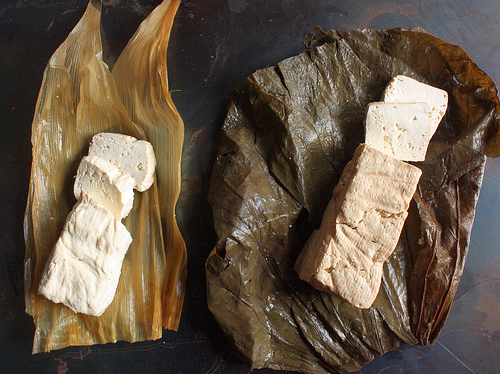
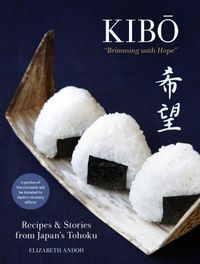
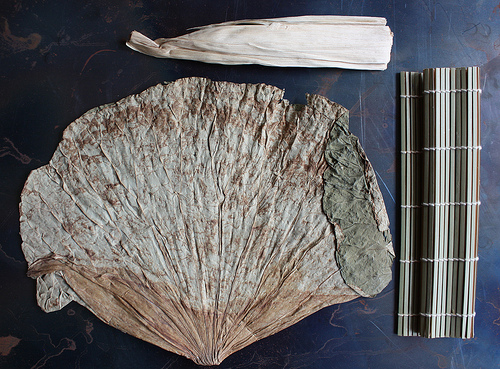
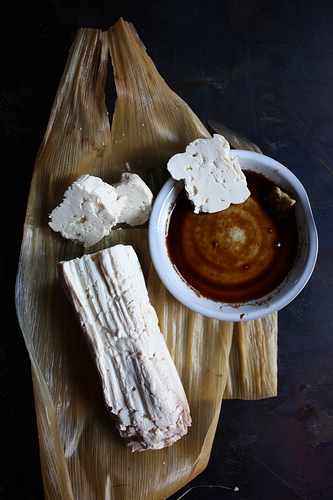
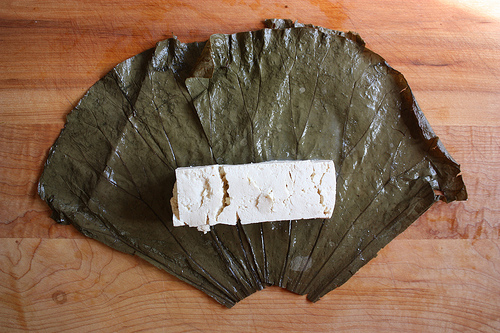
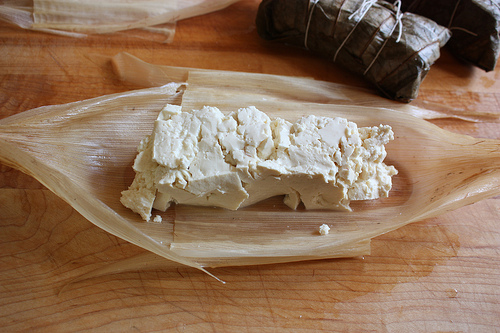




Robyn says
Wonderful Andrea, thank you.
Andrea Nguyen says
Glad you enjoyed the piece, Robyn!
elaine chan says
sounds interesting. Will definitely try it.
Andrea Nguyen says
It's magnificently simple, Elaine. Check it out.
Diane says
Looks great! Where do you get the lotus leaves?
I ordered the book today. She's a wonderful writer and it's a great cause.
Lara says
Love your blog - but was just subjected to an awful, noisy ad when I visited your site 🙁
Andrea Nguyen says
I get dried lotus leaves at a Chinese market. They are typically near the dried mushrooms. Ask for them. It's a big package.
Andrea Nguyen says
Sorry, Lara. Was it that Saint Lucia one? I'm going to get rid of it. Consider it gone! Thanks for the feedback.
stella@raplica handbags says
i like this one but dont have any source to get lotus leave....tell me where did you get it..if i get lotus leave i must try it once..
stella@raplica handbags says
very interesting tips and so easy to apply i feel you are a genious to solve our house hold problems...